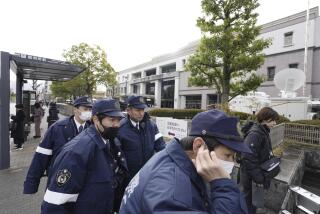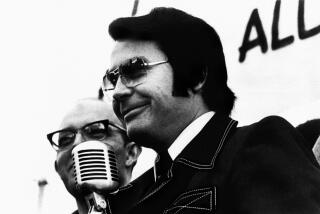Japanese Guru Arrested in Fatal Subway Attack : Crime: Shoko Asahara found during raid on cult’s Mt. Fuji compound. Warrant is first to link sect to poisoning.
- Share via
TOKYO — Japanese police arrested Aum Supreme Truth guru Shoko Asahara today on suspicion of murder in connection with the deadly poison gas attack against Tokyo subway riders, climaxing the nation’s biggest criminal investigation.
The arrest, carried out amid a heavy morning mist in a raid by 2,000 officers at the group’s compound near Mt. Fuji, promises to unravel the mysterious poisoning, which killed 12 people, sickened 5,500 others and deeply shook this normally tranquil nation.
Authorities announced they had found and arrested Asahara, 40, after taking four hours to scour the three-story building where they believed he was hiding.
Police arrested Asahara at 9:45 a.m. after discovering him meditating in a hidden room between the second and third floors of a cult building. Dressed in purple robes, he reportedly did not resist arrest and was pronounced in good health by a physician. Cult followers had insisted that Asahara was bedridden with liver disease and other ailments and could not survive outside the compound.
He was whisked in a police caravan to Tokyo for questioning.
Police had narrowed their search to the Mt. Fuji building, known as No. 6 Satian, based on sightings of Asahara’s wife and children, along with other clues, such as the daily purchase of expensive melons that the guru is known to love.
Asahara’s parents apologized to the nation for the “extraordinary trouble” their son had caused the public. Hiromu Nonaka, public safety commission chief, appealed to the estimated 10,000 Aum followers to return to the “safe and secure” Japanese society as responsible members.
In the first official charge that the cult had planned the March 20 subway attack, police Monday obtained an arrest warrant for Asahara and 40 other leaders.
With today’s arrests of 15 people, police have nabbed 27 of the 41 named in the warrant.
Confessions by cult members--and an apparent determination that the group no longer possessed any sarin that could be used in a counterattack--reportedly prompted the police to seek the long-anticipated arrest warrant.
A key development came Monday, when police nabbed Yoshihiro Inoue, the group’s intelligence chief, who is believed to have masterminded the attack, along with alleged kidnapings, firebombings and other illegal acts.
Police had feared the fervently loyal Inoue, 25, would stage violent acts of retaliation if they arrested Asahara. But Inoue was apprehended early Monday at a Tokyo roadblock in reportedly haggard condition. Although he had dyed his hair brown and shaved his beard, he was identified by his fingerprints.
Inoue was said to be keeping silent, but several other arrested members began confessing over the weekend, according to Japanese news reports.
In the most detailed account so far, Ikuo Hayashi, the group’s chief medical officer, reportedly confessed that he brought sarin into the subway with one accomplice, planted the lethal package on the floor between his feet and poked a hole into it with a sharpened nail attached to the end of an umbrella. He told police he was called into one of the group’s Tokyo offices the night before the attack and was assigned his accomplice.
Masami Tsuchiya, head of the group’s chemical squad, reportedly confessed that he made sarin four or five times and handed it over to unnamed cult officials shortly before the subway attack.
But Tsuchiya reportedly told police that the sarin he made was a diluted formula that had lost its potency by now. And because police sealed off the group’s chemical factories March 22, they determined no new sarin could have been produced.
Those factors, along with Inoue’s arrest, were critical in the decision to move ahead with the Asahara arrest warrant, Japanese media reported.
In extensive raids that yielded tons of toxic chemicals and cartons of documents, police reportedly seized a written order from Asahara to construct the chemical fortress in the Kamikuishiki village near Mt. Fuji and begin experiments to produce sarin.
Police suspect the group launched its project in the fall of 1993, when it began publicly discussing toxic gases in its in-house bulletins; the sect is believed to have succeeded in producing sarin for the first time last spring.
Authorities have also said they think the subway attack--centered in the government hub, known as Kasumigaseki--was a preemptive strike against police, who were investigating the group.
A few days before the sarin attack, police had borrowed gas masks and protective suits and received training on how to use them from the Self-Defense Forces, Japan’s military.
Cult spokesman Fumihiro Joyu has denounced the police actions as a witch hunt but refused to comment after Asahara’s arrest.
Despite widespread fear that they might commit mass suicide or engage in acts of violence, cult members shown on Japanese television left quietly and reportedly offered no resistance. Some parents of group members put up signs around the Mt. Fuji buildings, imploring their children to come home.
Meanwhile, Tokyo Gov. Yukio Aoshima said he will move swiftly to ask the courts to revoke the group’s status as a special religious corporation, which gives it tax breaks and other privileges.
(BEGIN TEXT OF INFOBOX / INFOGRAPHIC)
A Cult Chronology
Key incidents involving noxious fumes and the Aum Supreme Truth cult in Japan:
* March 5: About 10 people are taken to a hospital complaining of eye and respiratory pain after inhaling mysterious fumes in a train car in Yokohama.
* March 20: Sarin nerve gas spreads through Tokyo’s subway system during morning rush hour, killing 12 people and sickening more than 5,500.
* March 22: Police begin nationwide raids of Aum Supreme Truth facilities.
* April 19: Unidentified foul-smelling gas spreads through Yokohama station. About 500 people are hospitalized.
* April 21: A similar incident in a crowded Yokohama shopping center sends 24 people to hospitals.
* April 23: Hideo Murai, head of cult’s “science ministry,” is fatally stabbed by self-described rightist in front of reporters and police.
* April 26: Police arrest cult chemist Masami Tsuchiya.
* May 5: Authorities narrowly avert another disaster by extinguishing two burning bags of chemicals in a toilet in Shinjuku train station.
* May 15: Police arrest Yoshihiro Inoue, leading sect member suspected of supervising the subway attack.
* May 16: Police launch simultaneous nationwide raids, arresting cult leader Shoko Asahara and 14 others.
Source: Associated Press
More to Read
Sign up for Essential California
The most important California stories and recommendations in your inbox every morning.
You may occasionally receive promotional content from the Los Angeles Times.














